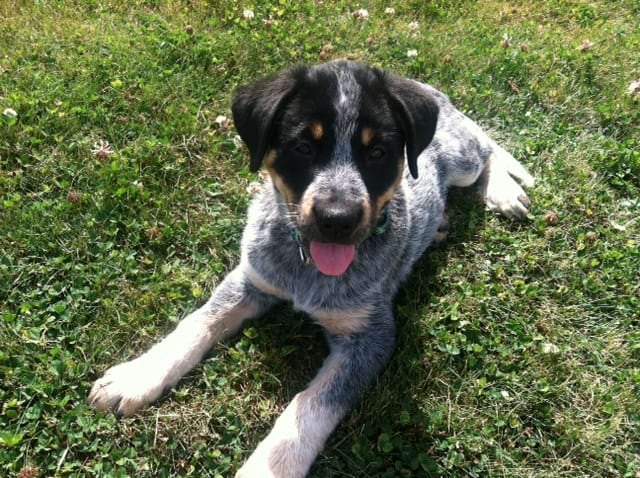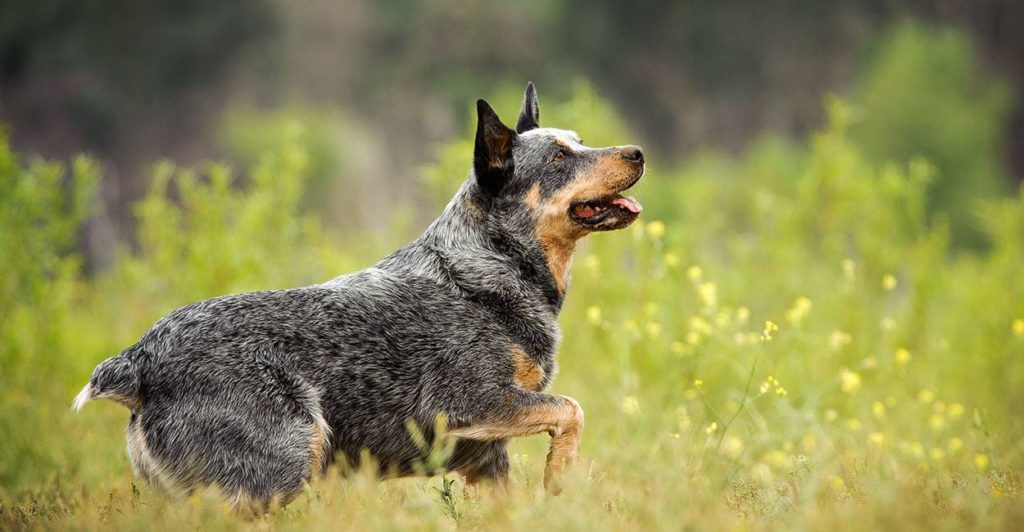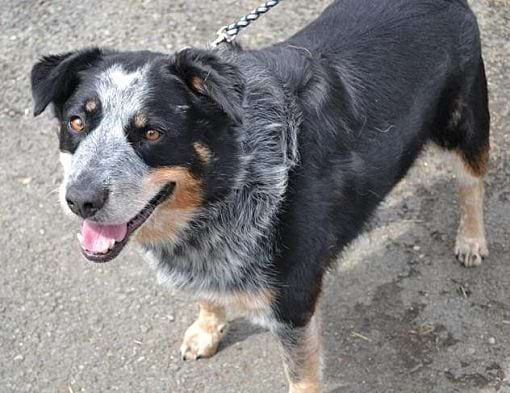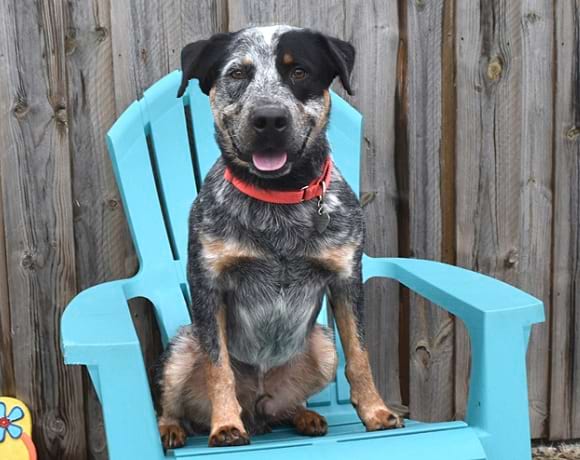The Rottweiler Blue Heeler Mix, also known as a Blueweiler, is a crossbreed between The Blue Heeler and the Rottweiler. This unique and striking breed is gaining popularity due to its loyal and protective personality and impressive physical characteristics.
Rottweiler Blue Heeler Mix is known for its intelligence, energy, and strong work ethic, making it an excellent choice for experienced and active owners. However, owning a Rottweiler Blue Heeler Mix requires significant time, attention, and training, as this breed can be challenging to handle without proper care.
In this article, we will explore the characteristics and traits of the Rottweiler Blue Heeler Mix to help you determine whether this breed is the right dog for you.
Brief overview of Rottweiler Blue Heeler Mix
| Breed Type: | Mixed Breed/Crossbreed (Blue Heeler and Rottweiler) |
| Size: | Medium to Large |
| Other Names: | Blueweiler, Australian Cattle Dog Rottweiler Mix, Cattle Dog Rottie Mix, Blue Heeler Rottie Mix, Rottie Cattle Dog |
| Guard/Watch Dog: | Yes |
| Weight: | 40-85 lbs (up to 100 lbs) |
| Height: | 8-27 inches |
| Lifespan: | 8-15 years |
| Living: | Large home with yard (not for apartments) |
| Coat: | Short to medium, double coat; various colors |
| Suitable for first time owners: | Not Recommended |
| Trainability: | Relatively Easy to Train, but requires an experienced or professional dog trainer |
| Hypoallergenic: | No |
| Shedding: | Moderate to High (more during spring and fall) |
| Grooming Needs: | 1-2 times/week (daily during shedding season) |
| Exercise Needs: | At least 120 minutes of exercise every day is required |
| Feeding and Diet: | 2.5 to 3.5 cups of high quality dog food each day, divided into two or three meals |
| Health Issues: | Canine Hip Dysplasia (CHD), Elbow Dysplasia, Deafness, Osteochondrosis Dissecans, Epilepsy, Allergies, Fairly High Rate of Cancer, Eye Issues, Heart Problems |
| Temperament: | Loyal, protective, alert, affectionate, etc. |
| Cat Friendly: | Yes, despite their high prey drive they can get along well with cats especially if raised together and socialized early |
| Dog Friendly: | Yes, But only with proper training and socialization from an early age |
| Kid Friendly: | Yes, they are best suited for families with older energetic kids (Early Socialization Is Required) (They do need to be watched around smaller kids) |
| Barking Tendencies: | Low; barks with reason |
| Price: | Average $400 – $1000 USD |
What is a Rottweiler Blue Heeler Mix?

The Rottweiler Blue Heeler Mix, often called the Blueweiler or Blue Heeler Rottie Mix, is a designer breed combining the Rottweiler and Australian Cattle Dog (Blue Heeler).
Originating in the U.S., this mix blends the Rottweiler’s strength and loyalty with the Blue Heeler’s energy and agility. As a result, it’s a versatile, robust companion dog, reflecting the best traits of both parent breeds.
Parent Breeds of Blue Heeler and Rottweiler Mix
Australian Cattle Dog History

The Australian Cattle Dog, also known as the Blue Heeler, has a fascinating history. It’s believed to have originated from the mating of Native Australian Dingoes with blue merle collies in the early days. Later, in 1840, Kelpies and Dalmatians were also crossed to refine the breed we know today.
Blue Heelers are renowned for their alertness, intelligence, and strong work ethic, but they require plenty of exercise to channel their boundless energy. Sometimes, their dynamism can lead to stubborn herding instincts, especially towards children and small animals.
Proper socialization is crucial to prevent shyness and behavioral issues. The Blue Heeler is a unique breed with a rich history, making them an intriguing and energetic companion.
Rottweiler history

The Rottweiler, a globally popular breed, has a captivating history rooted in the town of Rottweil, Germany. Initially bred as livestock protectors and herders, they were skilled at driving livestock between markets.
Beyond their reputation as guard and police dogs, Rottweilers have excelled in diverse roles, such as guide dogs for the blind and search and rescue work. They are the eighth most popular dog breed in the United States, known for their affection, confidence, and loyalty. These traits are inherited by the Blue Heeler Rott Mix from the Rottie.
What Does a Rottweiler Blue Heeler Mix Look Like?
The Blueweiler, a mix of Rottweiler and Blue Heeler, has a varied appearance. They can resemble either parent or be a blend of both. Typically large from their Rottweiler lineage, they may have delicate features from the Blue Heeler side. Eye color can range from the Blue Heeler’s striking blue to the Rottweiler’s darker hue. Overall, their look is always captivating and unpredictable.
Size and height
However, bursting with excitement, you can expect your full-grown Rottweiler Blue Heeler Mix to fall in the medium to the large category, tipping the scales from 40 to 85 pounds. And as for height, get ready for a surprise, as your doggo may stand between 18 and 27 inches tall.
But wait, that’s not all! The height and weight of your Blue Heeler Rottweiler Mix may also be affected by several other factors, such as diet, exercise, and genetics. Additionally, females may be smaller than their male counterparts, and the weight difference can be significant.
| Height | weight | Size Classification | |
| Male | 18 – 27 inches | 45 – 120 pounds | Medium to Large-Sized |
| Female | 17 – 24 inches | 35 – 100 pounds | Medium to Large-Sized |
Coat colors and types
When it comes to coat colors and types in this mixed breed, expect a short to medium-length coat.
But here’s the exciting part: the possibilities are diverse. It could inherit the classic black and tan look from the Rottweiler or sport a range of deep blue to silver blue shades from the Blue Heeler. Some pups might even have a mix of these colors, making it a bit of a surprise game.
Interestingly, even siblings from the same litter can have different coat colors, making it quite an adventure to see what your Blueweiler will look like.
Temperament and Personality
The temperament of the Rottweiler Blue Heeler Mix can be somewhat unpredictable, but one thing is certain: they are affectionate and devoted companions. They inherit protective instincts from the Rottweiler parent, making them excellent guard dogs and watchdogs. Additionally, they are loving and affectionate pets.
Their herding background makes them naturally cautious around strangers, which is great for protecting families with children and other pets, but proper socialization is important. These dogs have high energy levels, so they need plenty of exercise and playtime. They thrive on human interaction and can become anxious if left alone for extended periods.
Is Rottweiler Blue Heeler Mix a good fit for families?
Yes, with proper training and socialization, this designer dog can be a wonderful addition to your family. They are loyal and affectionate, enjoying time with their owners. Early socialization is essential, especially with kids and other pets.
While they can be warm and playful at home, they may be reserved outside their territory. Their herding instincts can make interactions with other dogs a challenge, but socialization can help.
It’s worth noting that their strong herding instincts may be a bit challenging for first-time dog owners, so experience can be helpful. Always supervise young or unfamiliar children around your Blueweiler for safety and happiness.
Are Rottweiler Blue Heeler Mixes aggressive?
No, Rottweiler Heeler Mix dogs are not naturally aggressive. However, aggression in any dog can arise from inadequate training and lack of socialization.
Rottweilers tend to be wary of strangers but usually won’t attack without provocation. On the other hand, Blue Heelers possess a pronounced herding instinct and might nip at heels to guide people. These traits can be present in a Rottweiler Heeler Mix.
Proper early training and diverse environmental exposure can mitigate these tendencies. It’s essential to remember that individual dogs may vary in behavior, so always be observant and consult a professional if behavioral issues arise.
Training

Training the Blue Heeler Rottweiler Mix requires positive reinforcement due to their intelligence and motivation. Novice dog owners may find their distractibility challenging.
Socialization is key for preventing overprotective tendencies and curbing herding instincts towards children and other animals. Proper socialization fosters good behavior and confidence. Avoid punishment and opt for treats and verbal praise to motivate your dog.
Exercise Requirements
Exercise is vital for the Rottweiler Blue Heeler Mix. They’re not suited for apartment living and require a minimum of 120 minutes of daily exercise to stay happy and healthy.
Lack of exercise can lead to excessive barking and destructive chewing. These intelligent dogs also need mental stimulation with interactive toys and games.
Without sufficient activity, they can display problematic behavior. Long walks, runs, and hikes are essential to burn their high energy levels and prevent destructive habits. Their working heritage demands regular exercise.
Grooming and Cleaning
Grooming and care for the Rottweiler Blue Heeler Mix are important despite their short coat. Regular brushing is necessary to prevent tangles and manage shedding. During shedding seasons, daily brushing may be required.
Bathing should be done using high-quality dog shampoo and grooming wipes to maintain their coat’s shine. Don’t forget nail trimming, ear cleaning, and teeth brushing to ensure overall hygiene and keep your pup happy and healthy.
| Grooming Needs | Grooming Frequency |
| Bathing | Once a month or as needed |
| Coat Brushing | Twice a week |
| Teeth Brushing | Three to four times a week |
| Ear Cleaning | Check and clean once a week |
| Nail Trimming | As needed or when nails become too long |
| Eye Cleaning | Regularly check and clean as necessary |
| Hair Trimming | As required for specific areas |
| Skin Care | Regularly check for any issues |
Are Rottweiler Blue Heeler Mixes hypoallergenic?
No, the Blue Heeler Rottweiler Mix is not considered hypoallergenic. Like many dogs, they produce dander and dried saliva, which can be trapped in their coat and become allergens. These allergens might trigger allergic reactions in some people. If someone is prone to dog allergies, it’s advisable
Do Rottweiler Blue Heeler Mixes shed a lot?
No, they don’t shed excessively, but it can vary. They may have a shedding pattern influenced by its parent breeds.
Rottweilers tend to shed more than Australian Cattle Dogs, but both breeds experience seasonal shedding, especially in the spring and fall. Consequently, a Blueweiler might shed more during these seasons to prepare for the changing weather.
Regular grooming and brushing can help manage and reduce the amount of shedding while maintaining a healthy coat.
Food and Diet
Proper nutrition is crucial for the high-energy Rottie Blue Heeler Mix. Feed them 2.5 to 3.5 cups of quality dog food daily, adjusting for age, size, and activity level.
Watch for overeating, especially if they inherit the Rottweiler’s appetite, to prevent weight gain. Enhance joint and coat health with wild Alaskan salmon oil and probiotics.
For dental health and a nutritious snack, consider frozen carrots, which also provide fiber, vitamin A, and potassium. Keep fresh water available daily to keep your pup hydrated.
Common Health Issues
Hold on to your hats, folks, because here are five (5) health issues that can affect the Blue Heeler Rottweiler Mix, so listen up!

1. Canine Hip Dysplasia
Canine Hip Dysplasia is a health issue that Rottweiler Blue Heeler Mix is prone to. The disease is genetic, and both parent breeds are susceptible to it. The condition is also called hip osteoarthritis, and it occurs when the hip joint does not grow at the same rate during the dog’s puppyhood. This causes limited mobility and reduced range of motion in affected dogs.
2. Deafness
Deafness is another health issue that Blue Heeler Rottweiler Mix may face. The Blue Heeler parent is prone to hearing problems, which can ultimately result in complete deafness. If your Blueweiler Mix doesn’t seem to respond to your commands or has excessive barking episodes, this may be a sign of hearing impairment.
3. Progressive Retinal Atrophy
PRA is a degenerative eye disease that can occur in Blue Heeler Rottweiler Mix dogs. The condition leads to the gradual deterioration of the retina, resulting in vision impairment and, ultimately, blindness. The first signs of PRA are often night blindness, where the dog struggles to see in low-light conditions, and clumsiness, as the dog starts bumping into objects in their path.
4. Hypothyroidism
Yo, is your Rottie Blue Heeler Mix experiencing hair loss on its tail and legs and dark patches on its skin? It could indicate hypothyroidism, an endocrine issue triggered by insufficient thyroid hormones.
5. Bloat
Bloat, also known as gastric dilation-volvulus, is a serious condition where your dog’s stomach fills with gas and twists, cutting off blood flow to vital organs. It can result from eating too fast, exercising after meals, or genetic factors.
Watch for signs like restlessness, pacing, and abdominal discomfort in your Blueweiler. If you suspect Bloat, seek urgent veterinary care immediately. Timely treatment is crucial, so don’t delay.
How Long Does a Rottweiler Blue Heeler Mix Live?
When it comes to mixed breeds, predicting the exact lifespan is challenging, but it’s estimated to be between 8 to 15 years. This range of life expectancy may seem perplexing. Still, it’s essential to consider various factors such as genetics, diet, exercise, and overall health when predicting the lifespan of a mixed-breed dog.
How Much Is a Rottweiler Blue Heeler Mix?
Well, the price tag is between $500 and $1,000. However, consider checking out rescue or adoption centers, as you can find your new furry friend for a lower price.
Is a Rottweiler Blue Heeler Mix The right Dog for me?
It depends on your lifestyle.
- If you’re a first-time dog owner or frequently away from home, this breed may not be ideal. They demand attention, training, and exercise.
- Living in a small space? Consider other options, as they thrive in larger, outdoor-friendly properties.
However, if you’re up for the challenge and can provide proper care, this mix can be a fantastic addition to your family, offering loyalty and love with the right training and exercise.
List of dogs that are similar to Rottweiler Blue Heeler Mix
- Blue Heeler-Catahoula Mix
- Blue Heeler-Husky Mix
- Blue Heeler-Australian Shepherd Mix
- Rottweiler-Husky Mix
- Rottweiler-Border Collie mix
- Rottweiler-Chihuahua Mix
- Rottweiler-Australian Shepherd Mix
- Blue Heeler-Catahoula Mix
Frequently Asked Questions
1. What Is A Rottweiler Blue Heeler Mix Called?
This mixed breed dog goes by several names, including the Blueweiler, Australian Cattle Dog Rottweiler Mix, Cattle Dog Rottie Mix, Blue Heeler Rott Mix, or Rottie Cattle Dog.
Choose the name that suits your fancy, as this unique blend of traits from its Blue Heeler and Rottweiler parent breeds will make a showstopping companion, whether you’re looking for loyalty, protection, or a hardworking herding dog.
2. Are Blue Heeler Rottweiler Mixes Protective?
Yes, Blue Heeler Rottweiler Mixes can be protective, particularly towards their families. This protective instinct may lead them to exhibit herding behavior around smaller children. Supervision and proper management of their herding tendencies are crucial when interacting with young kids to ensure a safe and harmonious environment.
3. Are Blue Heeler Rottweiler mixes Good With Kids?
Yes, Blue Heeler Rottweilers can be good with kids, especially older children who understand and respect a dog’s boundaries. Proper training and early socialization can make them great playmates.
However, their strong herding instincts might lead to attempts to herd younger children, which can be a concern. So, while they have the potential to be good with kids, it’s crucial to supervise their interactions with younger children to ensure the safety of everyone involved.
4. Are Rottweiler Blue Heeler Mixes Good with Other Dogs?
No, the Rottweiler Blue Heeler Mix might not be naturally good with other dogs. Their herding instincts, inherited from the Blue Heeler lineage, can make them initially reserved or standoffish.
However, with proper socialization and obedience training from a young age, they can learn to adapt and get along well with other dogs. Early exposure to various dogs and environments is essential to help them develop good canine social skills.
5. Can Blue Heeler Rottweiler Dogs Be Left Alone?
No, Blue Heeler Rottweiler dogs should not be left alone for extended periods. They can develop separation anxiety and engage in destructive behaviors when bored. To prevent these problems, it’s advisable to have someone present or arrange for a dog sitter or walker to keep them engaged and mentally stimulated in your absence.
6. How Long Can a Rottweiler Blue Heeler Mix Be Left Alone?
A Rottweiler Blue Heeler Mix should not be left alone for more than 4 to 6 hours, as they require social interaction and attention. Puppies, in particular, shouldn’t be left alone for more than 2 hours due to their need for extra care and their ongoing development of independence and maturity.
7. Are Blue Heeler Rottweiler Dogs High Maintenance?
No, Blue Heeler Rottweiler dogs are not high-maintenance in terms of grooming. They have short coats that don’t require excessive grooming.
However, they are high-maintenance when it comes to exercise and mental stimulation. These active and loyal dogs need regular exercise and dynamic training to burn off their abundant energy. If you’re seeking a low-energy, couch-potato type of dog, this breed is not the right choice.
9. Can a Rottweiler Blue Heeler Mix Be Off Leash?
No, it’s not recommended to have a Rottweiler Blue Heeler Mix off-leash. These dogs have a strong prey drive and may chase after small animals, posing a danger to both them and the animals. Keeping them on a leash ensures their safety and the safety of other animals in the area.
10.Are Rottweiler Blue Heeler Mixes Lazy?
No, Rottweiler Blue Heeler Mixes are not lazy. They are highly energetic and require a lot of daily exercise and playtime to stay healthy and happy. If you’re looking for a couch potato dog, this breed is not the right choice.
Conclusion
In conclusion, the Rottweiler Blue Heeler Mix is a unique and striking breed that combines the loyalty, energy, and intelligence of both the Blue Heeler and the Rottweiler.
While this breed can make an excellent companion for experienced and active owners, it is essential to understand that owning a Rottweiler Blue Heeler Mix requires significant time, attention, and training. By considering the temperament, health concerns, and exercise needs of this breed, you can decide whether the Rottweiler Blue Heeler Mix is the right dog for you.
With proper care and training, this breed can bring years of joy and companionship to its owner and serve as a loyal and protective guardian.

Pingback: Blue Heeler Corgi Mix: Exploring the Fascinating World 2023
Pingback: Blue Heeler Husky Mix: Interesting Facts You Need to know 2023
Pingback: Blue Heeler Jack Russell Mix: Revealing Hidden Wonders 2023
Pingback: Blue Heeler Rat Terrier Mix: Revealing Hidden Wonders 2023
Pingback: Blue Heeler Chihuahua Mix Dogs: All You Need To Know 2023
Pingback: Catahoula Blue Heeler Mix: Revealing Hidden Wonders 2023
Pingback: Mini Blue Heeler: Discover the interesting World of your dog 2023
Pingback: Rottweiler Husky Mix: Discover the Secrets to Nurturing 2023
Pingback: Border Collie Rottweiler Mix: Energetic Charm Unleashed 2023
Pingback: Australian Shepherd Rottweiler Mix: Strength Meets Loyalty 2024